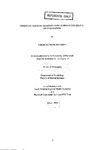COMPUTER ASSISTED LEARNING AND LEARNING DISABILITY: AN EVALUATION
| dc.contributor.author | BALDREY, SARAH PATRICIA | |
| dc.contributor.other | School of Psychology | en_US |
| dc.date.accessioned | 2013-10-09T12:06:21Z | |
| dc.date.available | 2013-10-09T12:06:21Z | |
| dc.date.issued | 1994 | |
| dc.identifier | NOT AVAILABLE | en_US |
| dc.identifier.uri | http://hdl.handle.net/10026.1/2125 | |
| dc.description.abstract |
The aim of this thesis is to evaluate the use of computer-assisted learning with people who have severe and profound learning disabilities. Theories of learning are central to our understanding of learning disability and contributions from the cognitive and behavioural schools are reviewed and related to methods of education and training for people with learning disabilities. This framework provides a rationale for understanding the premises of computer-assisted learning. A review of the literature reveals a lack of evidence for the efficacy of computer-assisted learning. Evaluation studies to date appear to be characterised by a lack of a methodologically sound framework. An evaluation survey of software designated for use with people with severe learning disabilities is presented which finds that much educational software lacks a sound grounding in established and effective principles of learning and teaching, although its use is still supported by instructors. Thus, the need for empirical research investigating the use and efficacy of computer-assisted learning in learning disability is identified. Psychological models provide an appropriate method of such an inquiry, though methodological problems inherent in evaluative research with a special population appear to act as a barrier to the development of effective knowledge in the area. Within these limitations, three experiments are presented. The first compares conventional teaching with computer-assisted teaching. The computer was as effective as the teacher, though the conventional measures of achievement used were not sensitive to any differences between the two methods. The second developed a more finegrain analysis which revealed a difference between the quality of participants' interaction with computer and teacher instruction. Specifically, attentional behaviour was increased in the computer-taught condition, yet there was no concomitant increase in learning. The reliance of educational software on sensory reinforcement was postulated as underlying the ability of computer-assisted learning to maintain attention to the task. The third experiment directly addressed the ability of three different sensory reinforcers typical of those found in educational software to support learning a simple discrimination task. It was found that sensory reinforcers were not effective in supporting learning, though they did maintain attention and performance on the task. It is suggested that the multiple modalities used by software may interfere adversely with the coding of relevant information involved in the discrimination of stimulus dimensions and that this may account for the discrepancy between measures of performance and measures of learning on computer-assisted tasks. | en_US |
| dc.description.sponsorship | South Western Regional Health Authority and Plymouth Community Services NHS Trust | en_US |
| dc.language.iso | en | en_US |
| dc.publisher | University of Plymouth | en_US |
| dc.title | COMPUTER ASSISTED LEARNING AND LEARNING DISABILITY: AN EVALUATION | en_US |
| dc.type | Thesis | |
| plymouth.version | Full version | en_US |
| dc.identifier.doi | http://dx.doi.org/10.24382/4412 | |
| dc.identifier.doi | http://dx.doi.org/10.24382/4412 |
Files in this item
This item appears in the following Collection(s)
-
01 Research Theses Main Collection
Research Theses Main


